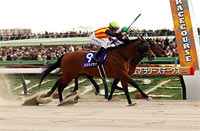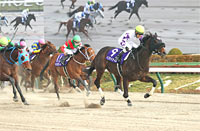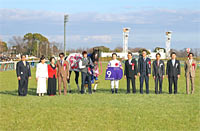February Stakes (G1) - Data Analysis
The ultimate contest in dirt racing, won by a long line of star horses
Of the 20 winners since the February Stakes was upgraded to Grade 1 status in 1997, more than two-thirds (14) had also culled wins in other G1 races, as well as top-level NAR graded dirt races (as of December 2016). In other words, the February Stakes has so far presented six horses with their only lifetime G1 win – or five, if we exclude the currently active Moanin (winner in 2016). The 2014 winner Copano Rickey was poorly favored, with win odds of 272.1 (16th favorite), but had won eight G1 and top-level NAR races by the end of 2016 (including the following year’s February Stakes), and took the title of Best Dirt Horse in the 2015 JRA Awards. So which of this year’s runners will win this first JRA G1 race of 2017, to stand alongside so many famous horses over the last two decades? This time, let’s analyze features shared by successful runners in this race from results over the last 10 years.
Look for a good finish last time out
Of 30 Top 3 finishers over the last 10 years, 26 had finished “In the Top 3” in their previous outing. By contrast, horses finishing “4th or lower” last time out have struggled to impress, only managing a Top 3 ratio of 5.2%. We should not expect much success from runners coming straight from a finish of 4th or lower in their previous race. [Table 1]
[Table 1] Performance by finish in previous race (last 10 years)
| Finish in previous race |
Performance
[1st-2nd-3rd-4th or lower] |
Win ratio |
Top 2 ratio |
Top 3 ratio |
| In the Top 3 |
9-8-9-56 |
11.0% |
20.7% |
31.7% |
| 4th or lower |
1-2-1-73 |
1.3% |
3.9% |
5.2% |
However, of the four Top 3 finishers coming straight from a finish of “4th or lower” last time out, all except 2014 winner Copano Rickey had won the previous year’s Mile Championship Nambu Hai (Morioka). A horse that won the previous autumn’s Mile Championship Nambu Hai (a 1,600m dirt race like this one) should be worth a punt, even if finishing “4th or lower” last time out. [Table 2]
[Table 2] Top 3 finishers beaten to "4th or lower" last time out (last 10 years)
| Year |
Finish |
Horse |
Finish last time out |
Finish in previous year’s Mile Championship Nambu Hai |
| 2008 |
2nd |
Blue Concorde |
5th |
1st |
| 2013 |
2nd |
Espoir City |
5th |
1st |
| 2014 |
1st |
Copano Rickey |
9th |
Did not run |
| 2015 |
3rd |
Best Warrior |
11th |
1st |
Check for runners last seen in 1,800m+ races
Of 30 Top 3 finishers over the last 10 years, 25 had most recently run in races over distances of “1,800m or more.” By contrast, runners last seen in races run over “Less than 1,800m” have been less successful, with a Top 3 ratio of only 6.3%. When comparing the runners’ pre-race build-up, we should be focusing on horses coming straight from races run over “1,800m or more.” [Table 3]
[Table 3] Performance by distance of previous race (last 10 years)
| Distance of previous race |
Performance
[1st-2nd-3rd-4th or lower] |
Win ratio |
Top 2 ratio |
Top 3 ratio |
| Less than 1,800m |
2-1-2-74 |
2.5% |
3.8% |
6.3% |
| 1,800m or more |
8-9-8-55 |
10.0% |
21.3% |
31.3% |
Meanwhile, of the five Top 3 finishers last appearing over distances of “Less than 1,800m,” all except 2012 winner Testa Matta had won that year’s Negishi Stakes in their previous outing. Of runners coming straight from races with distances of “Less than 1,800m,” we should have low expectations unless the previous outing ended with victory in the Negishi Stakes. [Table 4]
[Table 4] Top 3 finishers racing over "Less than 1,800m" last time out (last 10 years)
| Year |
Finish |
Horse |
Previous race |
Finish in previous race |
| 2007 |
3rd |
Big Grass |
Negishi Stakes |
1st |
| 2008 |
3rd |
Wild Wonder |
Negishi Stakes |
1st |
| 2012 |
1st |
Testa Matta |
Negishi Stakes |
3rd |
| 2nd |
Silk Fortune |
Negishi Stakes |
1st |
| 2016 |
1st |
Moanin |
Negishi Stakes |
1st |
Expect little from runners with low favoritism last time out
All 20 Top 2 finishers over the last 10 years had most recently appeared in a “Domestic race” and had been “5th favorite or higher” to win that race. Conversely, horses billed as “6th favorite or lower” last time out have a Top 3 ratio of only 4.8%. When comparing the runners’ previous race, we should check not only the finish and conditions but also the favoritism. [Table 5]
[Table 5] Performance by favoritism in the previous race when it was a "Domestic race" (last 10 years)
| Favoritism in previous race |
Performance
[1st-2nd-3rd-4th or lower] |
Win ratio |
Top 2 ratio |
Top 3 ratio |
| 5th favorite or higher |
10-10-8-88 |
8.6% |
17.2% |
24.1% |
| 6th favorite or lower |
0-0-2-40 |
0% |
0% |
4.8% |
Heavier horses tend to succeed
Of 30 Top 3 finishers over the last 10 years, 23 had weighed in at “500kg or more” for their previous race. By contrast, those weighing “Less than 500kg” last time out have tended to struggle, marking a Top 3 ratio of 10.6%. What’s more, the most recent winner with a body weight of “Less than 500kg” last time out was Sunrise Bacchus in 2007; every winner in the nine years since then weighed “500kg or more” in their previous race. When comparing pre-race data, the horse’s weight could be seen as an important pointer, alongside performance. [Table 6]
[Table 6] Performance by body weight last time out (last 10 years)
| Body weight in previous race |
Performance
[1st-2nd-3rd-4th or lower] |
Win ratio |
Top 2 ratio |
Top 3 ratio |
| Less than 500kg |
1-4-2-59 |
1.5% |
7.6% |
10.6% |
| 500kg or more |
9-6-8-70 |
9.7% |
16.1% |
24.7% |
In recent years, importance of a good record in JRA dirt races
All 15 Top 3 finishers over the last 5 years had previous experience of a Top 3 finish in “JRA open-class dirt race over 1,600-1,800m” since the previous year. In recent years, few runners lacking this experience have failed to live up to strong favoritism in this race, including Curren Black Hill in 2013 (finishing 15th as 1st favorite) and White Fugue in 2016 (10th as 5th favorite). We should not overestimate the chances of runners that lack this kind of record in JRA open-class dirt races since the previous year (such as horses mainly active in turf races or NAR graded dirt races). [Table 7]
[Table 7] Performance by experience of a Top 3 finish in "JRA open-class dirt 1,600-1,800 races" since the previous year (last 5 years)
| Experience |
Performance
[1st-2nd-3rd-4th or lower] |
Win ratio |
Top 2 ratio |
Top 3 ratio |
| Yes |
5-5-5-34 |
10.2% |
20.4% |
30.6% |
| No |
0-0-0-31 |
0% |
0% |
0% |
Seek out the winner!
Check the course aptitude
Each of the last five winners had previously experienced a Top 3 finish in “1,600m open-class dirt races held at Tokyo.” Other features shared by these five are that they had all been “5th favorite or higher” last time out, had weighed “500kg or more” last time out, and had experienced a Top 3 finish in “JRA open-class dirt 1,600-1,800 races since the previous year.” Any horse that has demonstrated strong course aptitude and has cleared the conditions set in Tables 5, 6 and 7 must be considered a leading contender to win this race. [Table 8]
[Table 8] Winning horses' "Highest finish in 1,600m open-class dirt races held at Tokyo," "Favoritism last time out," "Weight last time out" and "Highest finish in JRA open-class dirt 1,600-1,800 races since the previous year" (last 5 years)
| Year |
Winning horse |
Highest finish in 1,600m open-class dirt races held at Tokyo |
Favoritism last time out |
Weight last time out |
Highest finish in JRA open-class dirt 1,600-1,800 races since the previous year |
| 2012 |
Testa Matta |
2nd (2010 February Stakes) |
5th favorite |
502kg |
1st (2011 March Stakes) |
| 2013 |
Grape Brandy |
2nd (2011 Unicorn Stakes) |
4th favorite |
532kg |
1st (2013 Tokai Stakes, etc.) |
| 2014 |
Copano Rickey |
3rd (2013 Hyacinth Stakes) |
3rd favorite |
526kg |
1st (2013 Fukuryu Stakes) |
| 2015 |
Copano Rickey |
1st (2014 February Stakes) |
1st favorite |
538kg |
1st (2015 Tokai Stakes, etc.) |
| 2016 |
Moanin |
3rd (2015 Musashino Stakes) |
1st favorite |
526kg |
3rd (2015 Musashino Stakes) |
(Masaya Ibuki)
|

- Preview
- Barrier draw
- Past performances of runners

- News
- Race result
- Video
(English racecall for races after 2006)
- 2025

- 2024

- 2023

- 2022

- 2021

- 2020

- 2019

- 2018

- 2017

- 2016

- 2015

- 2014

- 2013

- Photo Gallery
2025 Winner: Costa Nova


2024 Winner: Peptide Nile


|




















